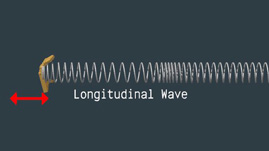Teachers' Domain - Digital Media for the Classroom and Professional Development
User: Preview



Animations and essays were created and written by Dr. Michael Gallis, the Pennsylvania State University.
Teachers who reviewed the collection were Patrick Callahan, Tara Clopper, and David R. McCachren. Instructional designer was Rucha Modak. Multimedia producer was Betsy Hutton. Director of Educational Services, Penn State Public Broadcasting is Dr. Babs Bengtson.

A wave is some sort of physical disturbance that carries energy from one place to another without carrying matter. Sound and light are two very common waves we encounter that have some similarities and some important differences.
One important aspect of a type of wave is how the disturbance moves relative to the direction the wave is travelling. In this silent animation a hand compresses a slinky to start a compression or longitudinal wave, a type of wave where the disturbance lines up with the direction the wave travels.
A wave is some sort of physical disturbance that carries energy from one place to another without carrying matter. While the word wave often conjures up memories of water waves on a pond, in the ocean or at the pool, there are many other kinds of waves that we come across in everyday life. Sound and light are two very common waves we encounter that have some similarities and some important differences.
One important aspect of a type of wave is how the disturbance moves relative to the direction the wave is traveling. Imagine a long line of people waiting patiently in the cafeteria, and someone toward the rear of the line stumbles and bumps the person in front of them. The bumped person bumps into the person in front of them, and so on. The disturbance (the bumping of people) travels on up the line and the front back motion of each individual in the line is along the direction the disturbance travels. Furthermore, none of the bumpers get to change their position in line as the disturbance propagates to the front of the line. We can contrast our traveling bump wave with the type of wave we often see in the stands at sporting events, where people move up and down (the disturbance) but the wave travels sideways across the stands.
A wave where the disturbance is lined up with the direction the wave will travel is called a longitudinal wave or a compression wave. A good example of a compression wave is sound. Compressions waves can occur whenever there is material that will spring back when compressed, which includes solids, liquids and gasses. As a result, sound can travel though just about any kind of matter.
Earthquakes produce vibrations which create waves that can travel through the earth. Geologists call the compression waves which travel through the earth P-waves or pressure waves. Because the speed of the P-wave depends upon the materials the wave travels through, monitoring the vibrations created around the globe by an earthquake helps scientists determine the nature of the interior of the earth. Earthquakes in a sense allow scientists to take a sonogram of the interior of the earth!
To learn more about basic properties of waves check out What Is a Wave?.
 Loading Standards
Loading Standards Teachers' Domain is proud to be a Pathways portal to the National Science Digital Library.
Teachers' Domain is proud to be a Pathways portal to the National Science Digital Library.
